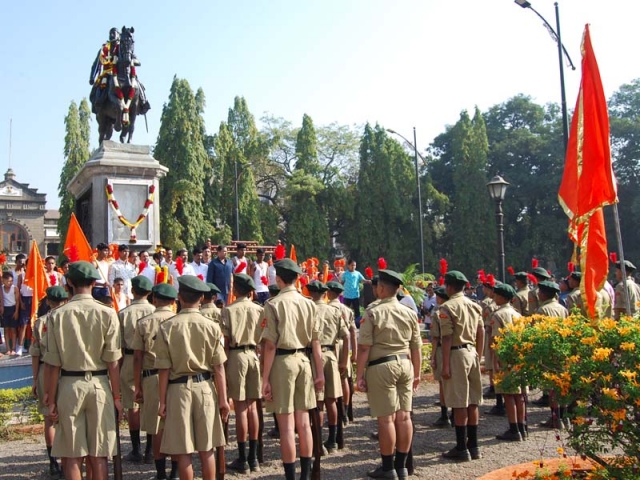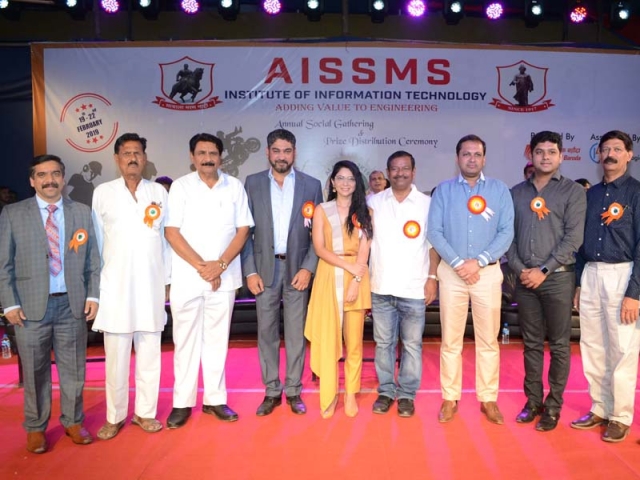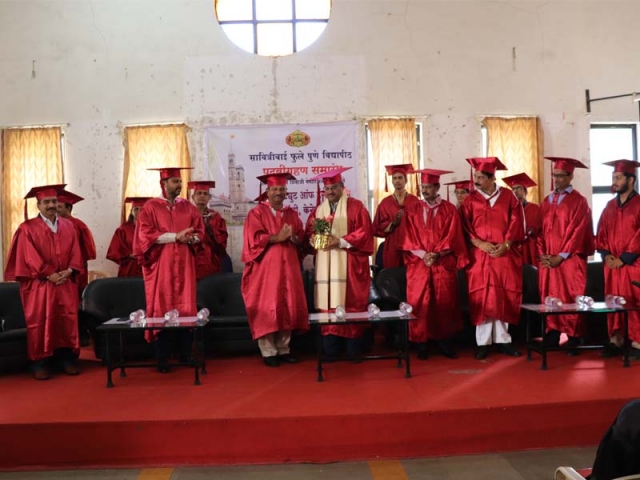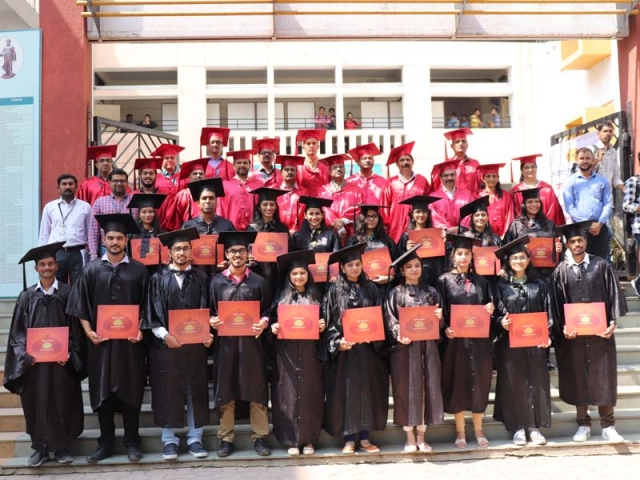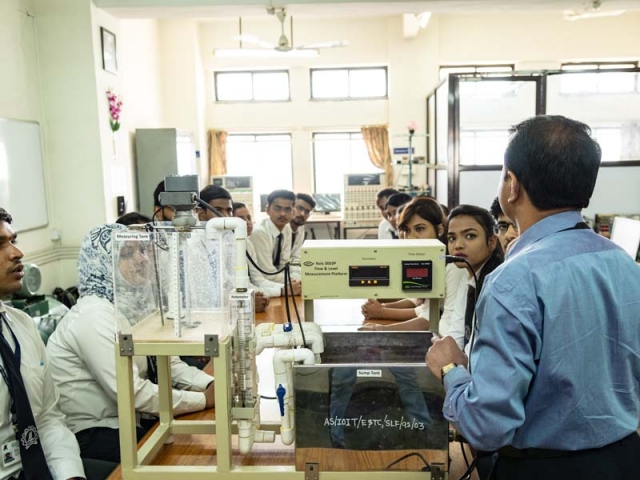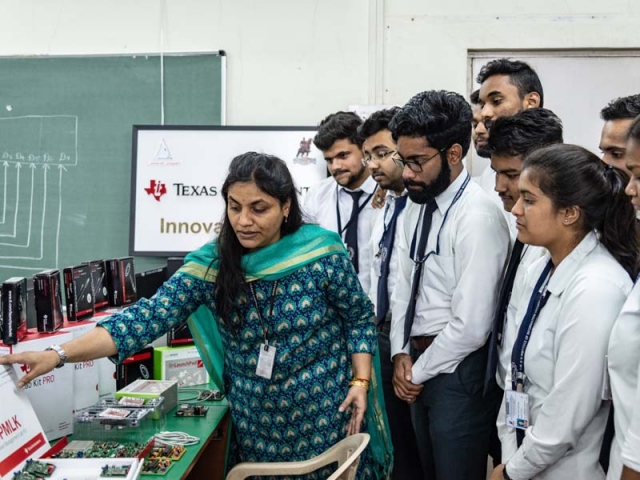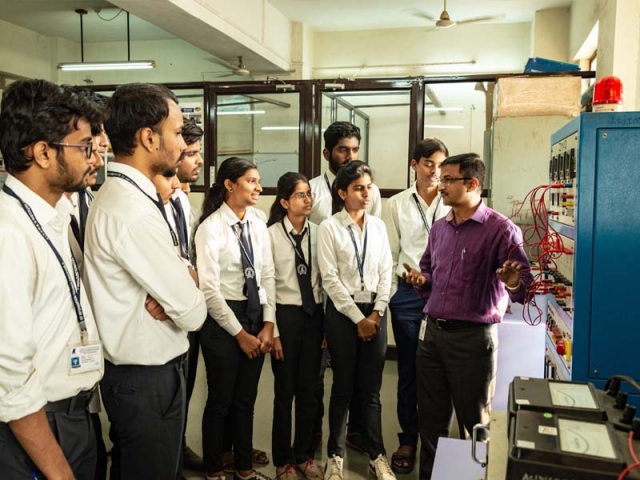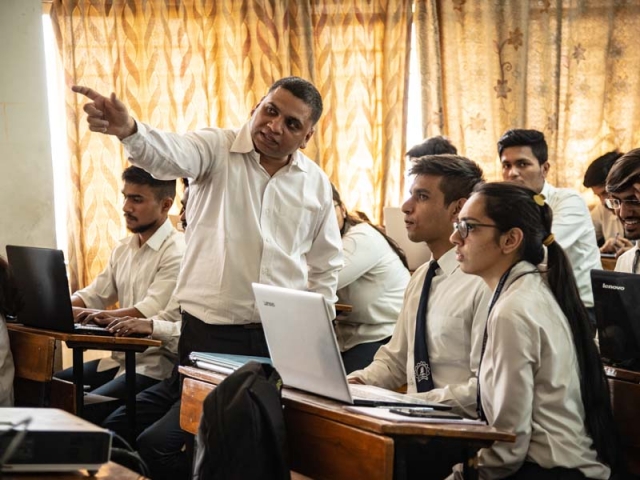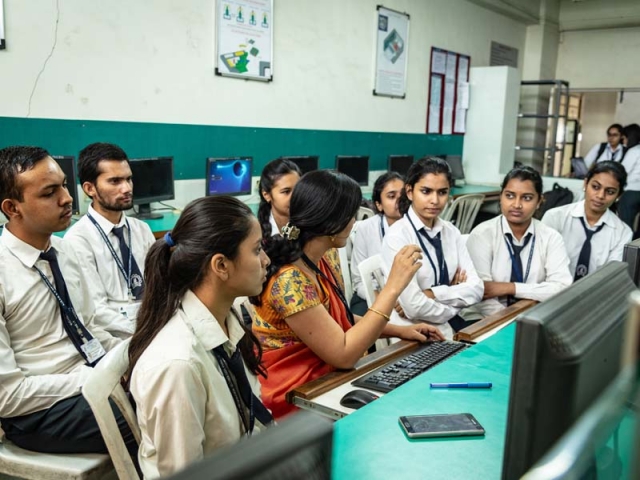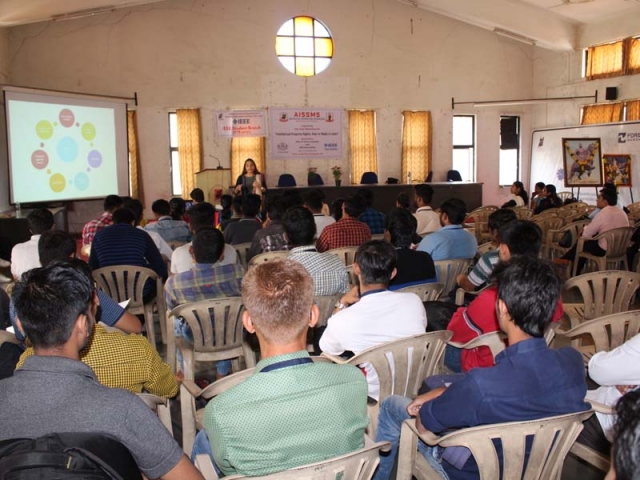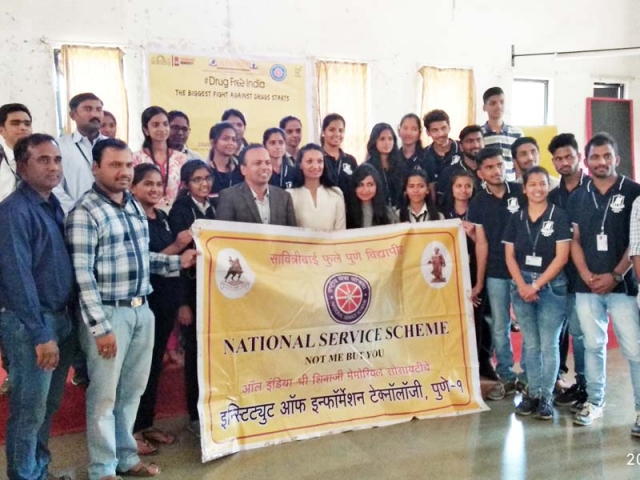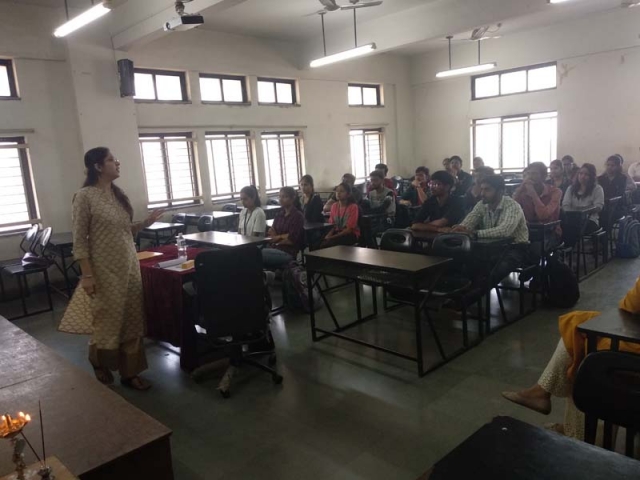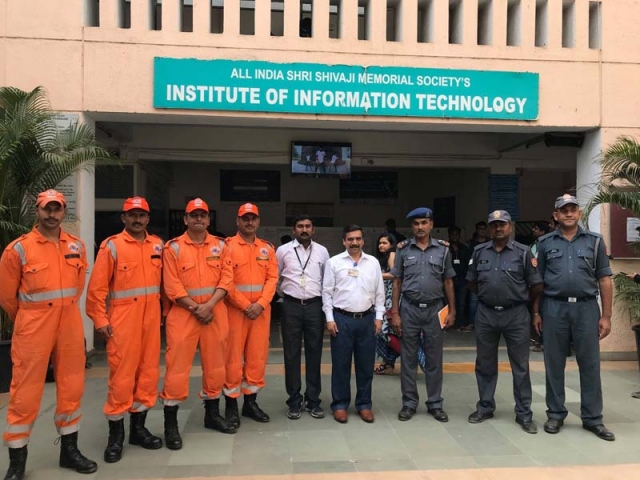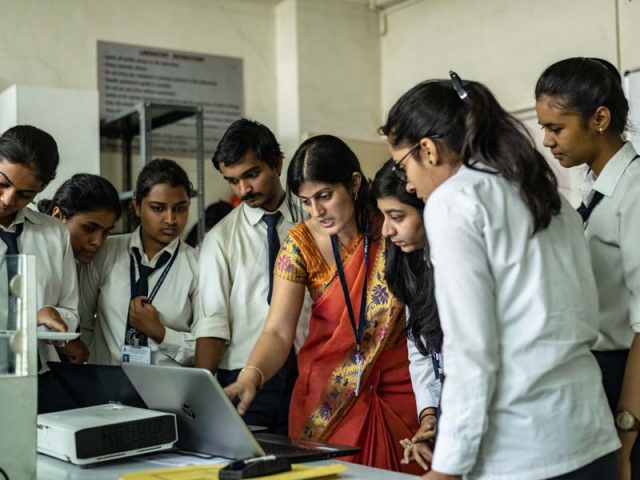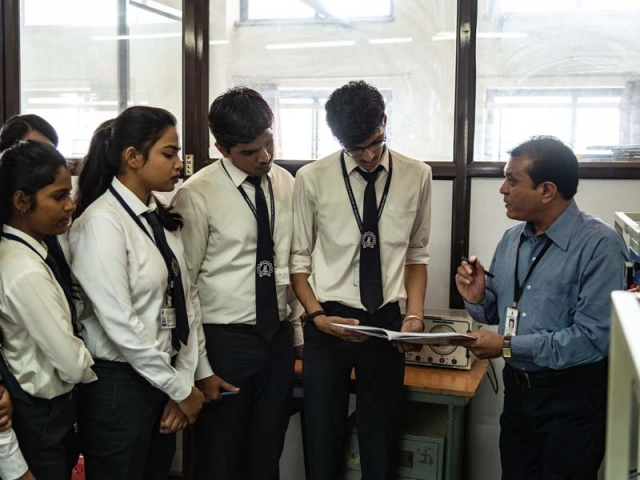Vision
Mission
● To inculcate research attitude and professional ethics for addressing the needs of industry.
Motto
Quality Policy
Program Educational Objective
2. Work in diverse career fields of information and communication technology.
3. Develop new methodologies and technologies for solving real-life problems.
PROGRAM SPECIFIC OUTCOMES
1. Apply domain-specific knowledge to analyze, design and develop electronics and telecommunication systems/applications in the field of Embedded Systems, Very Large Scale Integration (VLSI), Internet of Things (IoT), and Communication Technology.
2. Select and apply software and hardware tools such as Electronic Design Automation (EDA) and Test/Measurement equipment to solve engineering problems.
Program Outcomes
Engineering Graduates will be able to
| 1. | Apply the knowledge of mathematics, science, engineering fundamentals, and an engineering specialization to the solution of complex engineering problems.
[ Engineering knowledge] |
| 2. | Identify, formulate, review research literature, and analyse complex engineering problems reaching substantiated conclusions using first principles of mathematics,
natural sciences and engineering sciences. [Problem analysis] |
| 3. | Design solutions for complex engineering problems and
design system components or processes that meet the specified needs with appropriate consideration for the public health and safety, and the cultural, societal, and environmental considerations. [ Design/development of solutions]
|
| 4. | Use research-based knowledge and research methods including design of experiments, analysis and interpretation of data, and synthesis of the
information to provide valid conclusions. [ Conduct investigations of complex problems]
|
| 5. | Create, select, and apply appropriate techniques, resources, and modern engineering and IT tools including prediction and modelling to complex engineering activities with an understanding of the limitations. [ Modern tool usage]
|
| 6. | Apply reasoning informed by the contextual knowledge to assess societal, health, safety, legal and cultural issues and the consequent responsibilities relevant to the professional engineering practice. [ The engineer and society] |
| 7. | Understand the impact of the professional engineering solutions in societal and environmental contexts, and demonstrate the knowledge of, and need for
sustainable development. [ Environment and sustainability]
|
| 8. | Apply ethical principles and commit to professional ethics and responsibilities and norms of the engineering practice. [ Ethics]
|
| 9. | Function effectively as an individual, and as a member or leader in diverse teams, and in multidisciplinary settings. [ Individual and team work]
|
| 10. | Communicate effectively on complex engineering activities with the engineering community and with society at large, such as, being able to comprehend and write effective reports and design documentation, make effective presentations, and give and receive clear instructions. [ Communication]
|
| 11. | Demonstrate knowledge and understanding of the Engineering and management principles and apply these to one’s own work, as a member and leader in a team, to manage projects and in multidisciplinary environments. [ Project management and finance]
|
| 12. | Recognize the need for, and have the preparation and ability to engage in independent and life-long learning in the broadest context of technological change. [ Life-long learning]
|
| Course Outcome (COs) statements Second Year Engineering 2019 Pattern | |
| SE SEMESTER -I | |
| COURSE NAME: ENGINEERING MATHEMATICS-III [C201] | |
| Course Outcomes: Students will be able to | |
| C201.1 | Solve higher-order linear differential equations using appropriate techniques for modeling and analyzing electrical circuits. |
| C201.2 | Solve problems related to Fourier transform, Z-transform and applications to Communication systems and Signal processing. |
| C201.3 | Obtain Interpolating polynomials, numerically differentiate and integrate functions, numerical solutions of differential equations using single step and multi-step iterative methods used in modern scientific computing. |
| C201.4 | Transform physical phenomena into vectors, describe gradient, curl and divergence. Understand Vector Calculus and its applications to Electromagnetic field. |
| C201.5 | To solve Line, Surface, Volume integrals with their applications in engineering. |
| C201.6 | Analyse conformal mappings, transformations and perform contour integration of
complex functions in the study of electrostatics and signal processing. |
|
COURSE NAME: ELECTRONIC CIRCUITS [C202] |
|
| Course Outcomes : Students will be able to | |
| C202.1 | Compare the characteristics and parameters of MOSFET towards its applications. |
| C202..2 | Explain MOSFET amplifiers with and without feedback & MOSFET oscillators, for given specifications. |
| C202.3 | Analyze the performance of linear and switching voltage regulators towards applications in regulated power supplies. |
| C202.4 | Explain internal schematic of Op-Amp and define its performance parameters |
| C202.5 | Design, Build and test Op-amp based analog signal processing and conditioning circuits. |
| C202.6 | Identify principles of various data conversion techniques and PLL with their applications. |
| COURSE NAME: DIGITAL CIRCUITS [C203]
|
|
| Course Outcomes : Students will be able to | |
| C203.1 | Compare, design, implement and explain combinational and sequential circuit of different logic families. |
| C203.2 | Simplify and optimize digital circuit using different reduction techniques. |
| C203.3 | Analyse, design and implement combinational logic circuits |
| C203.4 | Design and implement sequential circuits. |
| C203.5 | Identify and design state machines using Mealy and Moore models. |
| C203.6 | Differentiate and implement semiconductor memories such as PLD, CPLD, FPGA etc. |
|
COURSE NAME: ELECTRICAL CIRCUITS [C204] |
|
| Course Outcomes : Students will be able to | |
| C204.1 | Analyze the simple DC and AC circuit with circuit simplification techniques |
| C204.2 | Formulate and analyze driven and source free RL and RC circuits. |
| C204.3 | Formulate & determine network parameters for given network and analyze the given network using Laplace Transform to find the network transfer function. |
| C204.4 | Explain construction, working and applications of DC Machines / Single Phase & Three Phase AC Motors. |
| C204.5 | Explain construction, working and applications of special purpose motors & understand motors used in electrical vehicles |
| C204.6 | Analyze and select a suitable motor for different applications. |
| COURSE NAME: DATA STRUCTURES [C205]
|
|
| Course Outcomes : Students will be able to | |
| C205.1 | Solve mathematical problems using C programming language. |
| C205.2 | Implement sorting and searching algorithms and calculate their complexity. |
| C205.3 | Develop applications of stack and queue using array. |
| C205.4 | Demonstrate applicability of Linked List. |
| C205.5 | Demonstrate applicability of nonlinear data structures – Binary Tree with respect to its time complexity. |
| C205.6 | Apply the knowledge of graph for solving the problems of spanning tree and shortest path algorithm. |
|
COURSE NAME: ELECTRONICS SKILL DEVELOPMENT [C206] |
|
| Course Outcomes : Students will be able to | |
| C206.1 | Select electronic component to build a circuit. |
| C206.2 | Identify analyse and Apply electronic principle and cognitive skills for given task. |
| C206.3 | Design, modify and Discuss basic electronic blocks and interpret specifications |
| C206.4 | Make use of any simulation software to design and test electronic circuit. |
| C206.5 | Assemble and utilize any electronic parts for basic industrial application. |
| C206.6 | To study batteries and solar power system. |
| SE SEMESTER -II | |||
| COURSE NAME: SIGNALS & SYSTEMS [C207] | |||
| Course Outcomes: Students will be able to | |||
| C207.1 | Identify, classify basic signals and perform operations on signals and systems based on their properties. | ||
| C207.2 | Identify, Classify the systems in terms of impulse response and determine the convolution between two signals. | ||
| C207.3 | Analyze and resolve the signals in the frequency domain using the Fourier series. | ||
| C207.4 | Analyze and resolve the signals in the frequency domain using Fourier Transform. | ||
| C207.5 | Analyze and resolve the complex signals and LTI systems in the frequency domain using Laplace Transform. | ||
| C207.6 | Compute probabilities, statistical averages, CDF, PDF of a random variable | ||
|
COURSE NAME: CONTROL SYSTEMS [C208] |
|||
| Course Outcomes: Students will be able to | |||
| C208.1 | Relate a physical system and express input-output relationships by means of block diagrams, mathematical models, and transfer functions. | ||
| C208.2 | Explain the relationships between the parameters of a control system and its stability, accuracy, transient behavior. | ||
| C208.3 | Analyze time-domain analysis like root-locus technique to control systems required for stability analysis. | ||
| C208.4 | Analyze frequency domain analysis Like Bode and Nyquist Plots technique to control systems required for stability analysis. | ||
| C208.5 | Model and analyze the control systems using state-space analysis. | ||
| C208.6 | Explain P, PD, PI, or PID controller based on the transient and steady-state response criteria. | ||
|
COURSE NAME: PRINCIPAL OF COMMUNICATION SYSTEM [C209] |
|||
| Course Outcomes : Students will be able to | |||
| C209.1 | To compute & compare the bandwidth and transmission power requirements. | ||
| C209.2 | Analyse the techniques of generation, transmission and reception of Amplitude Modulation Systems. | ||
| C209.3 | Explain generation and detection of FM systems. | ||
| C209.4 | Outline the importance of Sampling Theorem. | ||
| C209.5 | Compare digital representation techniques. | ||
| C209.6 | Explain waveform coding, multiplexing and synchronization techniques. | ||
| COURSE NAME: : OBJECT ORIENTED PROGRAMMING[C210] | |||
| Course Outcomes: Students will be able to | |||
| C210.1 | Define and explain the principles of object-oriented programming. | ||
| C210.2 | Apply the concepts of data encapsulation, inheritance in C++. | ||
| C210.3 | Define and make use of Operator overloading and friend functions in C++. | ||
| C210.4 | Apply the concepts of classes, methods inheritance, and polymorphism to write programs C++. | ||
| C210.5 | Apply Templates, Namespaces and Exception Handling concepts to write programs in C++. | ||
| C210.6 | Explain and make use of File handling in C++. | ||
| COURSE NAME: EMPLOYABILITY SKILLS DEVELOPMENT [C211] | |||
| Course Outcomes : Students will be able to | |||
| C211.1 | Outline and evaluate short-term and long-term goals using SWOC assessment. | ||
| C211.2 | Develop effective communication skills using self- management attributes. | ||
| C211.3 | Develop practically deployable skill set. | ||
| C211.4 | Enhance inter-personal relationships to excel in the professional environment. | ||
| C211.5 | Comprehend the importance of professional ethics throughout the career. | ||
| C211.6 | Develop skills and preparedness for analytical reasoning, aptitude tests and quantitative ability tests. | ||
| COURSE NAME: PROJECT BASED LEARNING [C212] | |||
| Course Outcomes : Students will be able to | |||
| C212.1 | Identify the real-world problem through a rigorous literature survey and formulate its aim and objectives. | ||
| C212.2 | Select a solution by strictly following professional ethics and safety measures. | ||
| C212.3 | Apply previously acquired knowledge to propose a suitable solution based on the fundamentals of electronics and communication engineering. | ||
| C212.4 | Analyse the results for valid conclusion. | ||
| C212.5 | Make use of technology in proposed work and demonstrate learning in oral and written form. | ||
| C212.6 | Develop ability to work as an individual and as a team member. | ||
| Course Outcome (COs) statements Third Year Engineering 2015 Pattern | |||
| TE SEMESTER -I | |||
| COURSE NAME: DIGITAL COMMUNICATION [C301] | |||
| Course Outcomes : Students will be able to | |||
| C301.1 | Identify the building blocks of digital communication system. | ||
| C301.2 | Explain the performance of a baseband transmitter system. | ||
| C301.3 | Interpret the aspects of random processes to improve the performance of the communication system. | ||
| C301.4 | Make use of the performance of an optimum baseband receiver system and error probability. | ||
| C301.5 | Make use of the performance of a passband transmission system. | ||
| C301.6 | Explain the performance of the spread spectrum communication system. | ||
|
COURSE NAME: DIGITAL SIGNAL PROCESSING [C302] |
|||
| Course Outcomes: Students will be able to | |||
| C302.1 | Describe and apply digital signal processing fundamentals and sampling theorem for A to D conversion of a signal with adequate sampling rates and analyze the aliasing process. | ||
| C302.2 | Represent DT signals in the frequency domain using DTFT, DFT, FFT, and Z transform and state their applications. | ||
| C302.3 | Represent discrete-time signals in the frequency domain using Z transform and analyze the system’s stability. | ||
| C302.4 | Identify, describe and design IIR filters. | ||
| C302.5 | Identify, describe and design FIR filters. | ||
| C302.6 | Develop different signal processing applications using DSP processor. | ||
| COURSE NAME: ELECTROMAGNETICS[C303] | |||
| Course Outcomes : Students will be able to | |||
| C303.1 | Make use of basic mathematical concepts related to electromagnetic vector fields. | ||
| C303.2 | Illustrate principles of electrostatics to solve problems of electric field, potential, boundary conditions and electric energy density. | ||
| C303.3 | Illustrate principles of magnetostatics to solve problems of magnetic field, potential, boundary conditions and magnetic energy density. | ||
| C303.4 | Demonstrate the Faraday ‘s law and Maxwell ‘s equations. | ||
| C303.5 | Explain the concept of transmission lines and its parameters. | ||
| C303.6 | Apply Maxwell‘s equations to electromagnetic wave (uniform plane wave), derive and interpret Helmholtz equation. | ||
|
COURSE NAME: MICROCONTROLLERS [C304] |
|||
| Course Outcomes: Students will be able to | |||
| C304.1 | Explain architecture and features of 8051 Microcontroller and develop assembly language programs. | ||
| C304.2 | Illustrate hardware and software tools for developing applications. | ||
| C304.3 | Develop interfacing to real world devices using 8051 microcontroller. | ||
| C304.4 | Explain architecture and features of PIC Microcontroller. | ||
| C304.5 | Explain and use PIC microcontroller functions in real-world interfacing. | ||
| C304.6 | Develop interfacing to real-world devices using a serial communication protocol of PIC microcontroller. | ||
|
COURSE NAME: MECHATRONICS [C305] |
|||
| Course Outcomes: Students will be able to | |||
| C305.1 | Identify key elements of mechatronics systems required for various applications. | ||
| C305.2 | Compare and select sensors or transducers as per the requirement of application area. | ||
| C305.3 | Make use of sensors for position, velocity and liquid flow measurements. | ||
| C305.4 | Differentiate and select hydraulic, pneumatic and electrical actuators. | ||
| C305.5 | Elaborate upon case study of mechatronics system design. | ||
| C305.6 | Prepare report and/or PowerPoint presentation on an industrial visit. | ||
|
COURSE NAME: ELECTRONICS SYSTEM DESIGN [C306] |
|||
| Course Outcomes : Students will be able to | |||
| C306.1 | Design, Analyse the working of electronics devices for specified electronic design system based on selection of components and device | ||
| C306.2 | Design prototype of data acquisition system using transducer and signal conditioning circuit. | ||
| C306.3 | Analyze and test the performance of various Designs of electronics systems by simulation software. | ||
| C306.4 | Develop the Design skills and ability to create, manage queries using modern design tools. | ||
| C306.5 | Design PCB taking into consideration the various design issues. | ||
|
TE SEMESTER -II |
|||
| COURSE NAME: POWER ELECTRONICS [C307] | |||
| Course Outcomes : Students will be able to | |||
| C307.1 | Determine, Analyse and Design Different Triggering and gate drive Circuits for Thyristor. | ||
| C307.2 | Determine, Analyse, Design and Test Power converters. | ||
| C307.3 | Analyse and test performance of motor drives, various power electronics applications like UPS, SMPS etc. | ||
| C307.4 | Evaluate battery backup time & design a battery charger. | ||
| C307.5 | Design & implement over voltage / over current protection circuit. | ||
| COURSE NAME: INFORMATION THEORY , CODING TECHNIQUES& COMPUTER NETWORK [C308] | |||
| Course Outcomes: Students will be able to | |||
| C308.1 | Perform information-theoretic analysis of communication systems. | ||
| C308.2 | Design a data compression scheme using a suitable source coding technique. | ||
| C308.3 | Design a channel coding scheme for a communication system. | ||
| C308.4 | Apply fundamental principles of data communication and networking. | ||
| C308.5 | Apply flow and error control techniques in communication networks. | ||
| C308.6 | Discuss and differentiate various communication protocols. | ||
| COURSE NAME: BUSINESS MANAGEMENT [C309] | |||
| Course Outcomes : Students will be able to | |||
| C309.1 | Explain the management science aspects required for business. | ||
| C309.2 | Compare the quality management tools used for business. | ||
| C309.3 | Interpret the aspects of finance management and project management. | ||
| C309.4 | Identify processes of human resource management. | ||
| C309.5 | Explain and make use of key elements of entrepreneurship skills. | ||
| C309.6 | Interpret the need of marketing and customer relationship management. | ||
|
COURSE NAME: ADVANCED PROCESSORS [C310] |
|||
| Course Outcomes: Students will be able to | |||
| C310.1 | Explain the need and application of ARM Microprocessors in embedded systems. | ||
| C310.2 | Describe the ARM7 microprocessor architectures and its feature. | ||
| C310.3 | Develop the embedded system with available resources. | ||
| C310.4 | Demonstrate the advanced peripherals using ARM7 based microcontroller. | ||
| C310.5 | Describe architecture, features of typical DSP Processor . | ||
| C310.6 | Explain and make use of DSP Processor and resources for signal processing applications. | ||
|
COURSE NAME: SYSTEM PROGRAMMING AND OPERATING SYSTEMS [C311] |
|||
| Course Outcomes: Students will be able to | |||
| C311.1 | Explain fundamental language processing activities to design and implement assemblers, macro processor using Linux platform. | ||
| C311.2 | Describe the significance of compilers, Linkers, and Loaders. | ||
| C311.3 | Discuss different types of operating systems along with the concept of process management and CPU scheduling algorithms implement on Linux platform. | ||
| C311.4 | Compare and analyses the different implementation approach of system programming operating system abstractions. | ||
| C311.5 | Classify memory management techniques and implement various page replacement algorithms in the operating system on Linux platform. | ||
| C311.6 | Describe Input-Output management and file system structure by case study of Linux OS. | ||
|
COURSE NAME: EMPLOYABILITY SKILLS AND MINI PROJECT [C312] |
|||
| Course Outcomes: Students will be able to | |||
| C312.1 | Solve real-life problems by applying knowledge of engineering fundamentals. | ||
| C312.2 | Plan a Mini Project with team members. | ||
| C312.3 | Design system using specifications from the datasheet. | ||
| C312.4 | Develop electronic hardware by learning PCB artwork design. | ||
| C312.5 | Demonstrate working model and prepare the technical report. | ||
| COURSE NAME: VLSI DESIGN& TECHNOLOGY [C401] | |
| Course Outcomes: Students will be able to | |
| C401.1 | Design various Digital systems having a set of objectives and design constraints using VHDL programming. |
| C401.2 | Implement VLSI Design Flow using PLDs. |
| C401.3 | Analyze different factors to be considered for floor planning, placement, and routing. |
| C401.4 | Apply CMOS technology-specific layout rules and design CMOS-based digital circuits. |
| C401.5 | Analyze various issues and constraints in the design of an ASIC. |
| C401.6 | Apply knowledge of testability in design and build self-test circuits. |
|
COURSE NAME: COMPUTER NETWORK & SECURITY [C402] |
|
| Course Outcomes: Students will be able to | |
| C402.1 | Define fundamental underlying principles of computer networking |
| C402.2 | Explain IPv4 addresses and network-layer protocols. |
| C402.3 | Relate network layer algorithms, unicast and multicast routing protocols. |
| C402.4 | Justify the importance of transport layer protocols |
| C402.5 | Apply basic knowledge of installation and configuration of networking applications |
| C402.6 | Apply knowledge of cryptography and network security |
|
COURSE NAME: RADIATION & MICROWAVE TECHNIQUES [C403] |
|
| Course Outcomes: Students will be able to | |
| C403.1 | Differentiate various performance parameters of radiating elements. |
| C403.2 | Analyse and design various radiating elements and arrays. |
| C403.3 | Apply the knowledge of waveguide fundamentals in design of transmission lines. |
| C403.4 | Design a system consisting of various passive microwave components. |
| C403.5 | Analyse tube based and solid-state active devices along with their applications |
| C403.6 | Choose a suitable microwave measurement instruments and carry out the required measurements. |
| COURSE NAME: ELECTIVE I- EMBEDDED SYSTEMS & RTOS [C404-C] | |
| Course Outcomes : Students will be able to | |
| C404-C.1 | Relate design metrics of embedded systems to design real time applications to match recent trends in technology. |
| C404-C.2 | Explain real time systems concepts. |
| C404-C.3 | Explain and apply features of μcos-II RTOS. |
| C404-C.4 | Choose and make use of advanced architecture for embedded systems. |
| C404-C.5 | Justify the use of Linux for embedded system development. |
| C404-C.6 | Explain and make use of an open platform for embedded system development. |
|
COURSE NAME: ELECTIVE II-ELECTRONICS PRODUCT DESIGN [C405-B] |
|
| Course Outcomes: Students will be able to | |
| C405-B.1 | Describe the concept & examine the various stages of Electronic product design. |
| C405-B.2 | Examine the various stages of hardware design & testing methods. |
| C405-B.3 | Compare various software development models and infer good programming practices. |
| C405-B.4 | Design PCB taking into consideration the various design issues. |
| C405-B.5 | Discuss the importance of Product Debugging & testing methods. |
| C405-B 1.6 | Explain the need, types, methods, and layout of documentation. |
|
COURSE NAME: ELECTIVE II-ELECTRONICS IN AGRICULTURE [C405-E] |
|
| Course Outcomes: Students will be able to | |
| C405-E 2.1 | Describe the Role of computers & virtual instrumentation |
| C405-E.2 | Explain communication solutions for interpreting environmental parameters with Electronics systems. |
| C405-E .3 | Describe Instrument technology used in agriculture |
| C405-E.4 | Apply knowledge of advanced technology in Agriculture. |
| C405-E.5 | Apply knowledge of Electronics in Agriculture. |
| C405-E.6 | Explain Greenhouse Technology & Role of Electronics Governance |
|
COURSE NAME: ELECTIVE I- INTERNET OF THINGS [C404-D] |
|
| Course Outcomes: Students will be able to | |
| C404-D.1 | Explain functional blocks, architecture, applications, and scope of IoT. |
| C404-D.2 | Compare and select sensors or transducers and actuators as per the requirement of a particular IoT system. Explain the role of WSN in IoT systems. |
| C404-D.3 | Explain various features and characteristics of wireless protocols in IoT. Also, explain the packet and messaging format of a wireless protocol in IoT. |
| C404-D.4 | Elaborate on various features and characteristics of IP-based protocols in IoT. |
| C404-D.5 | Explain and compare different types of big data and data analytics techniques also explain various characteristics of Hadoop. |
| C404-D.6 | Describe the applications of IoT in various fields with a case study and design a simple IoT system for various applications. |
|
COURSE NAME: PROJECT PHASE I [C406] |
|
| Course Outcomes: Students will be able to | |
| C406.1 | Solve real life problems by applying the knowledge of engineering fundamentals. |
| C406.2 | Implement practically, ideas/real time industrial problems/ current application of respective/multidisciplinary engineering branches. |
| C406.3 | Develop product considering safety, social and ethical standards by applying
project management skills. |
| C406.4 | Use different modern tools and equipment like LabView, Xilinx, MATLAB, multi sim, Keil, NS-II, spectrum Analyzer, Logic analyzer, MSO, Vector Network analyzer, etc. |
| C406.5 | Demonstrate acquired knowledge through projects by participating in various competitions. |
| C406.6 | Compose project Reports (proposals) and present their project work. |
|
BE SEMESTER -II |
|
| COURSE NAME: MOBILE COMMUNICATION [C407] | |
| Course Outcomes: Students will be able to | |
| C407.1 | Apply the concept of switching to design multistage network |
| C407.2 | Design networks using concepts of traffic engineering and signaling techniques. |
| C407.3 | Explain cellular concepts and their propagation mechanism. |
| C407.4 | Explore the architecture of GSM. |
| C407.5 | Explain GSM channels and GSM transmission concepts. |
| C407.6 | Differentiate and explain the concept of 4G LTE and 5G technologies. |
|
COURSE NAME: BROADBAND COMMUNICATION SYSTEMS [C408] |
|
| Course Outcomes : Students will be able to | |
| C408.1 | Identify, explain and analyse the Key Elements of Optical Fibber Systems. |
| C408.2 | Design Link power budget and Rise Time Budget by selecting proper system components. |
| C408.3 | Identify and analyze WDM components for advanced lightwave systems. |
| C408.4 | Explain Orbital Mechanics and Launchers. |
| C408.5 | Describe satellite subsystems. |
| C408.6 | Perform Satellite Link design for Up Link and Down Link. |
|
COURSE NAME: Elective III- AUDIO AND SPEECH PROCESSING [C409-C] |
|
| Course Outcomes: Students will be able to | |
| C409-C.1 | Describe, interpret colour television fundamentals, fault finding & servicing equipments and discriminate between television standards. |
| C409-C.2 | Describe digital television, MPEG standards, video compression techniques, display devices and prepare detailed report on visit to recording studio/broadcasting station. |
| C409-C.3 | Explain HDTV standards, digital TV satellite systems with preparation of case studies on digital broadcasting. |
| C409-C.4 | Explain IPTV systems, Mobile TV, Video projectors, and intercom systems. |
| C409-C.5 | Simulate audio, video, and image compression techniques and explain different audio and video recording techniques. |
| C409-C.6 | Explain studio acoustics, acoustics chambers, prepare a summary of different types of speakers and microphones. |
|
COURSE NAME: ELECTIVE IV – RENEWABLE ENERGY SYSTEMS [C410-D] |
|
| Course Outcomes : Students will be able to | |
| C410-D.1 | Interpret importance of energy conservation, energy reserves of India and potential of different energy sources. |
| C410-D.2 | Measure the solar energy parameters by computation of angles required to find out
sunrise, sunset, day length and performance of different solar energy collectors. |
| C410-D.3 | Explain the importance of solar photovoltaic systems and real time applications of solar energy . |
| C410-D.4 | Determine different parameters of wind turbine rotor necessary to produce wind energy. |
| C410-D.5 | Explain the importance and applications of geothermal and ocean energy. |
| C410-D.6 | Explain working of fuel cell |
| COURSE NAME: PROJECT PHASE II [C411] | |
| Course Outcomes : Students will be able to | |
| C411.1 | Solve real life problems by applying the knowledge of engineering fundamentals. |
| C411.2 | Implement practically, ideas/real-time industrial problems/ current application of respective/multidisciplinary engineering branches. |
| C411.3 | Develop product considering safety, social and ethical standards by applying project management skills. |
| C411.4 | Use different modern tools and equipment like LabView, Xilinx, MATLAB, multisim, Keil, NS-II, spectrum Analyzer, Logic analyzer, MSO, Vector Network analyzer etc. |
| C411.5 | Demonstrate acquired knowledge through projects by participating in various competitions. |
| C411.6 | Compose project Reports (proposals) and present their project work. |
